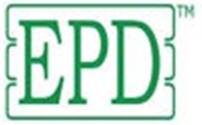What is an EPD?
An EPD (Environmental Product Declaration) is a certified declaration informing users on the environmental impact of a specific product or service.
It uses the LCA methodology (ISO 14040ff) providing details of key environmental impacts. It is based on a PSR (Product Specific Requirement).

What is a PSR?
A PSR (Product Specific Requirement) specifies and details important criteria for inclusion in an EPD. The PSR will establish the most important environmental impacts for a given product type or category, and define how they are quantified, measured or calculated.
Independent experts and the general public are invited to review the PSR documents prior to developing an EPD.
Does it have a label?
There is a label that advises the public that the product has an EPD.
What is the ISO status?
The EPD is an ISO type III eco-label. Work is in the process to make it a full ISO standard (ISO/TR 14025:2000).
Are there any EPD available on the market?
There are many EPD systems on the market (e.g, KELA in Korea, JEMAI in Japan, NHO in Norway, APAT in Italy etc.) all with a slightly different focus.
For examples see.
How is an EPD used?
Suppliers of goods and service use them to inform their customers of the products environmental impact.
Can an EPD be used in green procurement?
Yes, as it is independently verified and nearer to an LCA than alternative labels it can be consider a superior tool to most other environmental indications.
What are the benefits of an EPD?
It allows customers to integrate data into their own systems.
It allows customer to focus on their specific area of interest.
It allows product performance, quality and safety aspects to be taken into consideration.
Is it correct to describe a product as having an EPD label?
Yes, according to international convention of the ISO standards it is a type III label. Not to use the term would be misleading, as it would not be in line with the international agreed use of the term.











